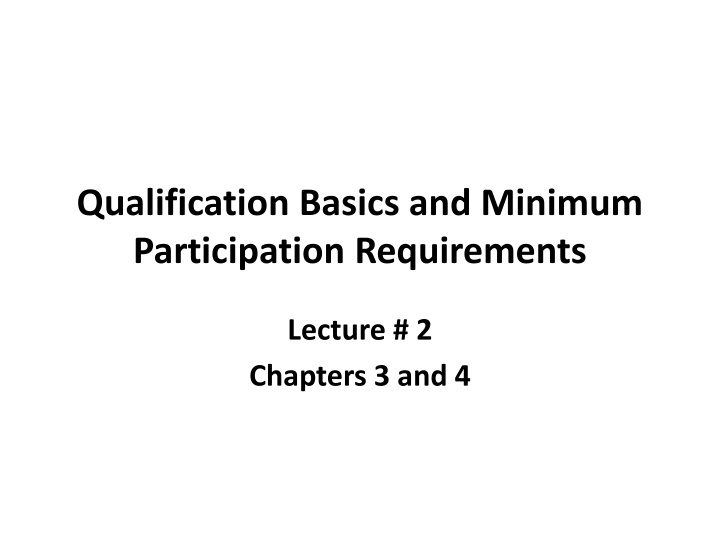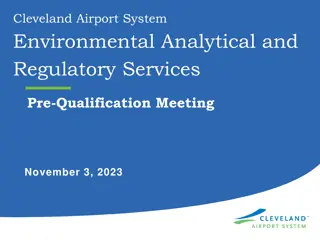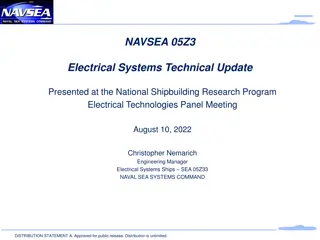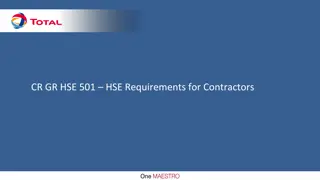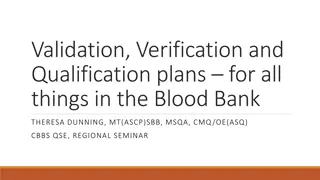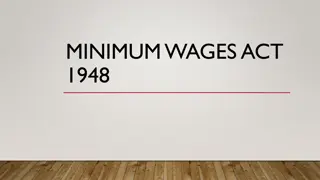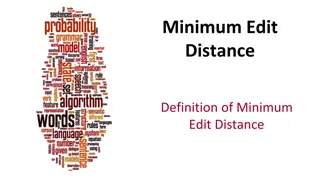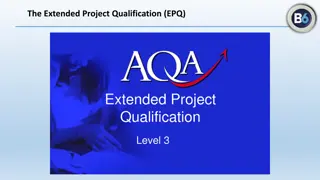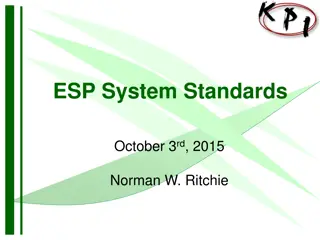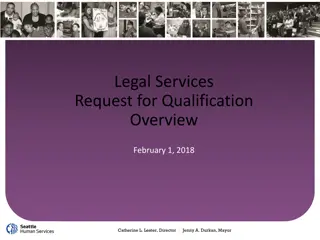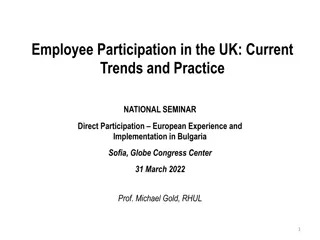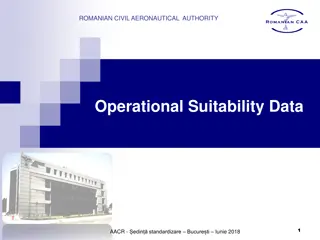Qualification Basics and Minimum Participation Requirements
This lecture covers essential aspects of qualification requirements for benefit plans, including written documentation, trust arrangements, minimum participation standards, accrual and vesting rules, commencement of benefits, spousal annuities, plan mergers, assignment and alienation restrictions, security provisions, IRC regulations, nondiscrimination policies, full vesting upon plan termination, and minimum distribution requirements. Understanding these criteria is crucial for ensuring compliance and fairness in benefit plans.
Download Presentation

Please find below an Image/Link to download the presentation.
The content on the website is provided AS IS for your information and personal use only. It may not be sold, licensed, or shared on other websites without obtaining consent from the author.If you encounter any issues during the download, it is possible that the publisher has removed the file from their server.
You are allowed to download the files provided on this website for personal or commercial use, subject to the condition that they are used lawfully. All files are the property of their respective owners.
The content on the website is provided AS IS for your information and personal use only. It may not be sold, licensed, or shared on other websites without obtaining consent from the author.
E N D
Presentation Transcript
Qualification Basics and Minimum Participation Requirements Lecture # 2 Chapters 3 and 4
Qualification Requirements Written plan document must have a definite written program or arrangement Trust - all plan assets must be held in trust (except insurance contracts) Exclusive benefit - plan must be operated for the exclusive benefit of participants and beneficiaries Minimum participation standards - plan is limited in its ability to impose minimum age, minimum service, or maximum age for participation
Qualification Requirements Contd Minimum Accrual and Vesting - benefits must be earned (accrue) and vest at certain minimum rates and become non-forfeitable after certain time periods Commencement of benefits - plan must provided that, unless the participant elects otherwise elects, payment of benefits will begin no later than certain date. Spousal annuities - plan must provide participants who are married joint and survivor annuity See Exception: Both participant and spouse elects another form
Qualification Requirements Contd Plan Mergers - plan must provide the determination of participant s benefit after merger or transfer of assets/liabilities to another plan Assignment and Alienation - plan must provide benefits may not be assigned or alienated Security for significant underfunding - Limitation on amendments to a DB plan if underfunding would result (exception for Multiemployer Plans) unless security is provided
Qualification Requirements Contd IRC - No ERISA Counterpart Sections Permanency plan document must imply permanent program Incidental Benefits - plan primarily provides retirement benefits. Other benefits (death, life insurance, disability etc) incidental Minimum Coverage - plan must cover a fair cross section of employees, and a fair percentage of non- highly compensated employees compared to highly compensated employees
Qualification Requirements Contd Nondiscrimination - contribution, benefits, rights and features of the plan cannot discriminate in favor of the highly-compensated employees Full Vesting Upon Plan Termination Plan must provide for full vesting upon termination (in certain cases upon partial termination) Minimum Distribution generally plan must commence distribution upon participant reaching age 701/2 Exception apply
Qualification Requirements Contd Limitation on Contributions, Benefits, Elective Deferrals - plan must provide for benefits or contributions that do not exceed statutory limits (See: IRC 415, 401(g), 4019(a)(16), (30) Limitation on Includible Compensation - plan must limit the annual compensation of each employee taken into account under the plan (see: IRC 401(a)(17)) Defined Benefit Plan Forfeitures forfeitures cannot be used to increase benefits
Qualification Requirements Contd Top-Heavy Requirements plan must have required allocation of accrued benefits if becomes top heavy Direct Transfer of Eligible Rollover Distribution plan must allow participants to elect direct trustee-to- trustee rollover of eligible distributions Minimum Funding - generally DB and Money Purchase plans Failure to meet minimum funding requirements do not lead to disqualification. Excise tax applies
Qualification Requirements Contd Anti-Cutback Rule plan must prohibit cutback of participant s earned benefit(s). May reduce prospectively (not retroactively) 401(k) ADP Testing and Distribution Requirement Reporting and Disclosure - Plan must meet certain reporting and disclosure requirements quarterly/annually
Qualification Requirements Contd Mechanics of qualification - plan is not required to seek an advance determination that it meets the qualification requirements BUT recommended Form 5300 IRS will issue when advance determination is requested Remedial Amendment Period: plan may be retroactively amended to bring into compliance with all qualification requirements Generally applies after statutory changes
Minimum Participation Requirements Eligibility Minimum Age and Service Requirements Plan may require both age and service requirements Age Requirement Age cannot exceed 21 years may be more liberal Plan cannot have a maximum age for participation Exception: plan maintained by educational institutions see: IRC 410(a)(1)(B)(ii); ERISA 202(a)(1)(B)(ii) Years of Service Requirement In general, plan cannot require, as a condition of participation, that an employee complete a period of service extending beyond later of: Date employee reaches age 21, or Date employee completes one year of service (see: exception for 2 years of service rule)
Minimum Participation Requirements Cont d - Eligibility General Rule: One year service requirement plan may not require more than one year of service for eligibility purposes Exception: Two year service rule - if the plan provides for two years of service on condition of becoming a participant, then must provide for immediate vesting, i.e. participants as 100% vesting in all benefits that accrue This option is not available to 401(k) plans
Minimum Participation Requirements Cont d - Eligibility Measuring a year of Service - plan may use Counting method or Elapse time Counting Method: must keep track of service based on eligibility computation period at least 1,000 hours of service credited during the eligibility computation period Elapse Time Method: service is credited based on the employee s period of employment Plan determines employee s period of service and translate into whole years of service (eligibility is determined by treating 12 months of service as equivalent to a year of service) employee s period of service begins on the date first credited with an hour of service for performance of duties
Minimum Participation Requirements Cont d - Eligibility Definition of Hour of Service a time of service determined under regulations prescribed by the Secretary of Labor Hours credited for performance of services: Each hour of service for which employee is paid, or entitled to payment for performance of duties for the employer (hours worked) Hours credited for non-performance of services: Each hour of service for which employee is paid, or entitled to payment for which no duties are performed (paid leave) Hours credited with respect to back pay award: Each hour for which back pay is either awarded or agreed to by the employer (back pay)
Minimum Participation Requirements Cont d - Eligibility Equivalency Methods Non-hourly workers - If employer does not want to keep track of hours can use equivalency method (skewed in favor of employee) Equivalency based on working time count hours worked or regular time Equivalency based on period of employment hours credited based on a unit of time. Actual hours not used Equivalency based on earnings hours based on employee s hourly rate of earnings for the computation period (Monthly or annual salaried employees earnings)
Minimum Participation Requirements Cont d - Eligibility No double credit allowed: no credit is given if the same hours have already been credited Entitled to be paid: to ensure employee receives proper credit regardless to if employer actually pays Option if 1000 hours not met: if the employee does not have 1,000 hours during the eligible computation period have two options: Keep counting from anniversary date to anniversary date switch to plan year (plan language must allow)
Minimum Participation Requirements Cont d - Eligibility Entry Dates: the dates a eligible employee must begin participating in the plan. Assume the employee has completed one year of service. When can the employee begin participation? Maximum Wait Time: To be qualified, a plan must provide that an otherwise eligible employee can participate no later than the earlier of: 1. The first day of the first plan year beginning after the date on which the employee satisfies the minimum age and service requirements, OR 2. The date 6 months after the date on which the employee satisfied the minimum age and service requirements. See IRC 410(a)(4) Exception: Where the employee is separated from service
Minimum Participation Requirements Cont d - Eligibility Semi-annual entry dates: plan can provide a semi- annual entry date system, i.e., first day of plan year and first day of the 7thmonth of the plan year Note: For purposes of participation, vesting, and benefit accrual, generally determined by reference to years of service (participation; vesting) and years of participation (benefit accrual ). Eligibility Computation period: The 12-month period in which the hours of service are measured.
Minimum Participation Requirements Cont d - Eligibility General Rule: computation period is 12 consecutive months, beginning with the employee s employment commencement date ( ECD ) = initial eligibility computation period (complete 1,000 hours of service) Hours credited for earlier period not accumulated, i.e., not rolled over from one period to the next Subsequent computation period: plan can designate subsequent computation period to begin after the initial computation period (or ECD). Subsequent computation periods would begin on the first day of the plan year following the end of the initial computation period. Generally, some overlap between first and second computation periods Break In Service: When an employee terminates employment, generally active participation in the plan ceases. Same effect can occur if employee s schedule cause hours of service to fall below required level. What happens if employee returns to employer? When does a break in service occur? How does it affect the employee s re-entry to the plan ?
Minimum Participation Requirements Cont d - Eligibility Break in service - General Rule: For eligibility purposes, the plan use the eligibility computation period to determine if a break in service has occurred Definition of a Break in Service: a 12-month period (consecutive) during which an employee is credited with not more than 500 hours of service plan must include specific provision that address the break in service rule If the plan does not include such language, an employee who has already satisfied the eligibility requirements re- enters the plan immediately on re-employment date Employers would like to disregard service earned prior to break in service. Two rules apply to determine if this can be done
Minimum Participation Requirements Cont d - Eligibility Rules that generally preclude disregarding pre-break service: One-Year Hold out Rule: (temporarily disregard prior service). If the employee has a one-year break in service, suspend taking prior service into account until the employee has completed a year of service after such break in service. Retroactively reinstate prior years of service Rule of Parity: where the employee has consecutive one-year breaks in service (i.e., more than one year break) prior years of service can be disregarded if the number of i-year breaks in service equals or exceeds the greater of: 1. Five (5), OR 2. The aggregate number of years of service before such period-break in service
Minimum Participation Requirements Cont d - Eligibility Requirements to be met for Rule of Parity: No double counting years of service required to be taken into account for non-vested participants cannot be counted in subsequent break in service periods Special rule for certain leave: participants on maternity, paternity, FMLA or military leave under USERRA must be credited up to 501 hours of service FMLA = Family Medical Leave Act USERRA Uniform Services Employment and Re- employment Act This rule applies solely for determining whether a break in service has occurred.
